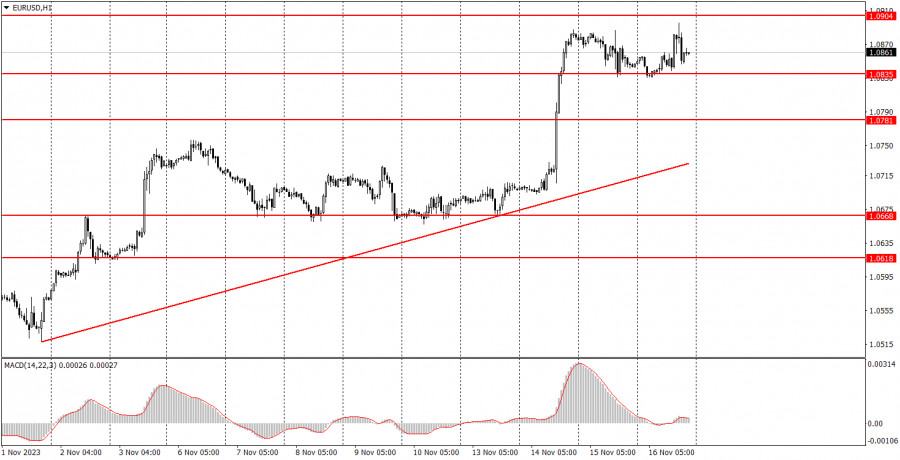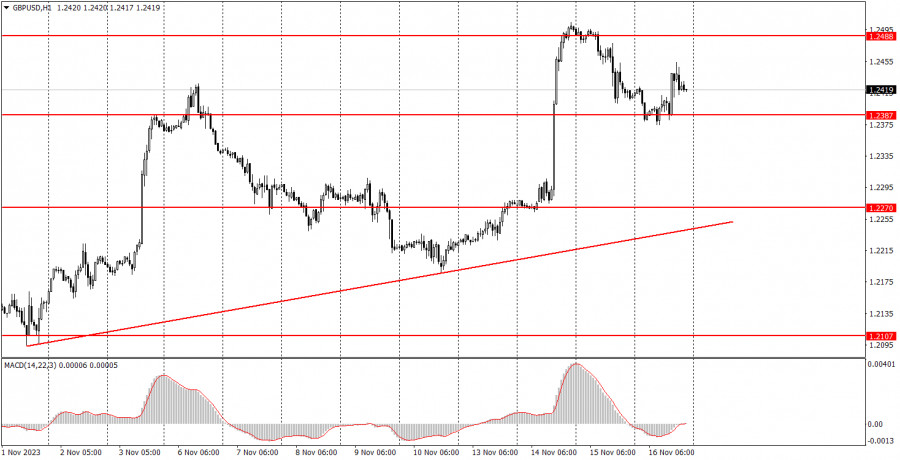

There are hardly any macroeconomic events on Friday, and few of them hold any importance. Let's start with the UK retail sales data, followed by the second estimate of the eurozone Harmonized Index of Consumer Prices for October. In the US, reports on housing and building permits will be released. In regards to the inflation data, we shouldn't expect surprising values since the second estimate rarely differs from the first. The UK retail sales report might be interesting, but market reaction will only be possible in case of a significant deviation from the forecast. The same also applies to the U.S. report.
Analysis of fundamental events:There are hardly any fundamental events planned for Friday. This week, several European Central Bank and Federal Reserve representatives have already spoken, but none of them made any loud statements. However, we already warned you that it would be difficult to expect resonant rhetoric in the current circumstances. On Friday, ECB President Christine Lagarde will speak again, along with several of her colleagues. However, Lagarde has already said that the Bank intends to maintain the current rate rather than raise it. From the Fed, Barr, Collins, Goolsbee, and Daly will speak. The effect is likely to be similar. From the Bank of England, we can expect to hear from Dave Ramsden.

On Friday, there will be a good number of events and reports, but none of them will be significant. We can pay attention to the three aforementioned reports, but we should only expect a mild market reaction to each data.
Basic rules of a trading system:1) Signal strength is determined by the time taken for its formation (either a bounce or level breach). A shorter formation time indicates a stronger signal.
2) If two or more trades around a certain level are initiated based on false signals, subsequent signals from that level should be disregarded.
3) In a flat market, any currency pair can produce multiple false signals or none at all. In any case, the flat trend is not the best condition for trading.
4) Trading activities are confined between the onset of the European session and mid-way through the U.S. session, post which all open trades should be manually closed.
5) On the 30-minute timeframe, trades based on MACD signals are only advisable amidst substantial volatility and an established trend, confirmed either by a trend line or trend channel.
6) If two levels lie closely together (ranging from 5 to 15 pips apart), they should be considered as a support or resistance zone.
How to read charts:Support and Resistance price levels can serve as targets when buying or selling. You can place Take Profit levels near them.
Red lines represent channels or trend lines, depicting the current market trend and indicating the preferable trading direction.
The MACD(14,22,3) indicator, encompassing both the histogram and signal line, acts as an auxiliary tool and can also be used as a signal source.
Significant speeches and reports (always noted in the news calendar) can profoundly influence the price dynamics. Hence, trading during their release calls for heightened caution. It may be reasonable to exit the market to prevent abrupt price reversals against the prevailing trend.
Beginning traders should always remember that not every trade will yield profit. Establishing a clear strategy coupled with sound money management is the cornerstone of sustained trading success.